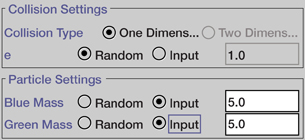Module 2
1. Module 2
1.12. Page 3
Module 2—The Conservation of Momentum in Isolated Systems
Collisions and Kinetic Energy
In an isolated system, if the total energy is conserved, does this imply that the kinetic energy is conserved? Recall that kinetic energy is the energy of motion ![]() . Any object that is moving not only has momentum but also has kinetic energy. In previous lessons, you discovered that the total momentum of an isolated system is conserved during a collision. But what about kinetic energy—is it also conserved?
. Any object that is moving not only has momentum but also has kinetic energy. In previous lessons, you discovered that the total momentum of an isolated system is conserved during a collision. But what about kinetic energy—is it also conserved?
Lesson 2 Lab: Kinetic Energy and Collisions
In this lab, a simulation will be used to collect velocity and mass data from five different collisions. The data will be used to test the conservation of kinetic energy and momentum in each collision.
Problem
Are kinetic energy and momentum always conserved in an isolated system that involves the collision of two objects?
Procedure
-
Use the Collision 1D simulator to investigate five different collisions between the same objects and complete the table in LAB 1. The data collected will be used to verify that momentum is conserved and to determine if kinetic energy is also conserved.
-
On the simulation, toggle “Show CM” and “Show CM Frame” to the off position (
 ).
).
-
Click the “Options” buttons (
 ), and enter the settings shown here.
), and enter the settings shown here.
-
set e to “Random”
-
set Blue Mass to “Input” with a mass of 5.0 kg
-
set Green Mass to “Input” with a mass of 5.0 kg
-

-
To generate a new collision (without changing the value of e or object mass), click the “New” button (
 ) and change the initial velocity of the blue ball by adjusting the velocity slider (
) and change the initial velocity of the blue ball by adjusting the velocity slider ( ) to any value.
) to any value.
-
After each collision, view the collision information by clicking the “Data” button (
 ) and fill in the appropriate table.
) and fill in the appropriate table.
 Module 2: Lesson 2 Assignment
Module 2: Lesson 2 Assignment
Remember to submit the answers to LAB 1 and LAB 2 to your teacher as part of your Module 2: Lesson 2 Assignment.
Observations and Analysis
LAB 1. In the chart below, record the initial velocity and final velocity for each object and the e value for the collision. Calculate the initial and final momentum and energy for each object using the mass and velocity values.
Do not worry about what e represents; it will be discussed in detail in the next section. The value of e will be listed with the other information on the simulation and must be recorded for each collision.
Collision 1 e = ____ |
|||||||
Object |
mass |
|
|
|
|
Ek initial |
Ek final |
blue |
5.0 |
|
|
|
|
|
|
green |
5.0 |
|
|
|
|
|
|
total |
----- |
----- |
----- |
|
|
|
|
Collision 2 e = ____ |
|||||||
Object |
mass |
|
|
|
|
Ek initial |
Ek final |
blue |
5.0 |
|
|
|
|
|
|
green |
5.0 |
|
|
|
|
|
|
total |
----- |
----- |
----- |
|
|
|
|
Collision 3 e = ____ |
|||||||
Object |
mass |
|
|
|
|
Ek initial |
Ek final |
blue |
5.0 |
|
|
|
|
|
|
green |
5.0 |
|
|
|
|
|
|
total |
----- |
----- |
----- |
|
|
|
|
Collision 4 e = ____ |
|||||||
Object |
mass |
|
|
|
|
Ek initial |
Ek final |
blue |
5.0 |
|
|
|
|
|
|
green |
5.0 |
|
|
|
|
|
|
total |
----- |
----- |
----- |
|
|
|
|
Collision 5 e = ____ |
|||||||
Object |
mass |
|
|
|
|
Ek initial |
Ek final |
blue |
5.0 |
|
|
|
|
|
|
green |
5.0 |
|
|
|
|
|
|
total |
----- |
----- |
----- |
|
|
|
|
Conclusion
LAB 2. Answer the following questions using the data collected in the collision tables:
-
Is momentum conserved in each collision?
-
Is kinetic energy conserved in each collision?